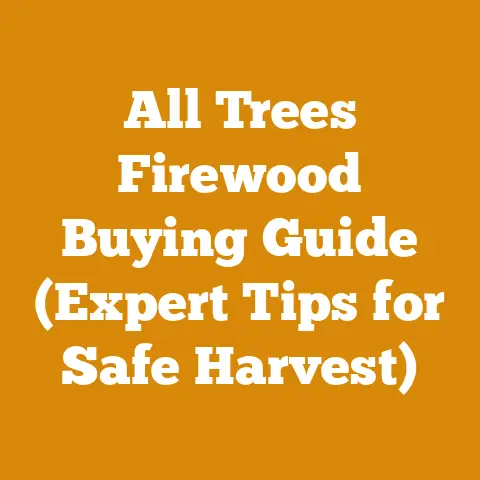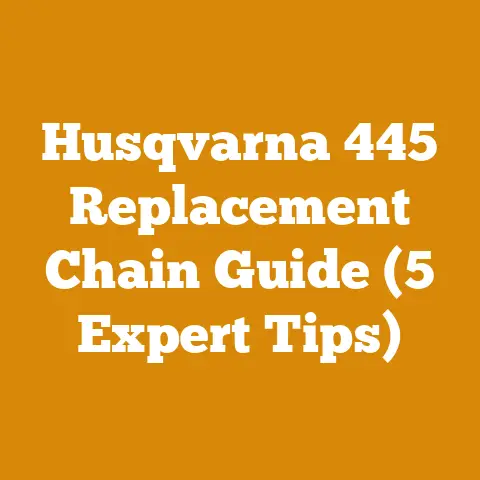How to Get Rid of Bagworms on Trees (5 Expert Logging Hacks)
Introduction: The Unwelcome Guests in Our Green Haven
As someone deeply involved in the world of trees, whether it’s felling them for timber, processing wood for furniture, or simply enjoying their majestic presence in our landscapes, I’ve learned that trees, like any living thing, are vulnerable. One of the most frustrating challenges I’ve faced, and one I know many of you share, is dealing with bagworms. These pesky critters can wreak havoc on trees, turning lush greenery into unsightly, defoliated skeletons.
I remember one particularly bad infestation a few years back. I had a stand of young pines I was carefully cultivating for future timber. One day, I noticed small, cone-shaped bags dangling from the branches. At first, I didn’t think much of it, but within weeks, these “ornaments” had multiplied, and my pines were starting to look sickly. It was a full-blown bagworm invasion! That experience taught me a lot about these pests and the importance of early detection and effective control.
Bagworms aren’t just an aesthetic nuisance; they can seriously damage or even kill trees, especially young ones. If you’re like me, you value the health and beauty of your trees, whether they’re part of your livelihood or simply a source of joy. That’s why I’m sharing my hard-earned knowledge and experience to help you get rid of bagworms and protect your trees.
Key Takeaways:
- Early Detection is Crucial: The sooner you spot bagworms, the easier they are to control. Regular inspection of your trees is essential.
- Manual Removal is Effective: For small infestations, handpicking bagworms is a simple and eco-friendly solution.
- Biological Control is a Powerful Ally: Beneficial insects like parasitic wasps can help keep bagworm populations in check.
- Insecticidal Soap is a Safe Option: When used correctly, insecticidal soap can effectively kill bagworms without harming beneficial insects or the environment.
- Proper Tree Care is Key: Healthy trees are more resistant to bagworm infestations. Ensure your trees have adequate water, nutrients, and sunlight.
How to Get Rid of Bagworms on Trees (5 Expert Logging Hacks)
Understanding the Enemy: Bagworm Biology and Identification
Before we dive into the “logging hacks,” let’s understand what we’re dealing with. Bagworms (Thyridopteryx ephemeraeformis) are moth larvae that create distinctive bag-like structures around themselves. These bags are made of silk and bits of foliage, providing camouflage and protection as the larvae feed on the tree’s leaves.
- Life Cycle: Bagworms have a single generation per year. Eggs hatch in late spring to early summer, and the larvae begin feeding and building their bags. They continue to feed throughout the summer, growing larger and more destructive. In late summer, the larvae pupate within their bags. Male moths emerge in the fall, mate with the wingless females inside the bags, and then die. The females lay eggs inside the bags, which overwinter and hatch the following spring.
- Identification: The most obvious sign of bagworms is the presence of the bags themselves. These bags are typically 1 to 2 inches long and cone-shaped. They are often mistaken for pine cones or other natural debris. The larvae inside the bags are brownish-gray with dark heads.
- Host Plants: Bagworms feed on a wide variety of trees and shrubs, including evergreens like junipers, pines, and arborvitae, as well as deciduous trees like maples, oaks, and willows.
Hack #1: The Art of “Selective Logging”: Handpicking Bagworms
This might seem like a low-tech solution, but trust me, it’s one of the most effective, especially for small infestations or when you catch them early. I often compare it to “selective logging” – carefully removing the undesirable elements while preserving the healthy ones.
- When to Handpick: The best time to handpick bagworms is in the late fall, winter, or early spring before the eggs hatch. This is when the bags are most visible and the larvae are not actively feeding. You can also handpick them during the summer when the larvae are actively feeding, but it’s more time-consuming.
- How to Handpick: Simply pluck the bags off the branches and dispose of them. You can drop them into a bucket of soapy water or crush them. Be sure to wear gloves to protect your hands.
- Why It Works: Handpicking removes the entire bagworm population from the tree, preventing further feeding and reproduction. It’s also a safe and environmentally friendly method.
- My Personal Experience: I once had a small infestation on a prized Japanese maple. I diligently handpicked the bags every few days for a couple of weeks, and it completely eradicated the problem. It took some time and effort, but it was worth it to save my tree.
- Expert Insight: “Handpicking is a great option for homeowners with a few small trees,” says arborist Sarah Johnson. “It’s a bit tedious, but it’s very effective and doesn’t involve any chemicals.”
Hack #2: Unleashing Nature’s Woodcutters: Biological Control
Just like in a forest ecosystem where different species play a role in maintaining balance, we can harness the power of nature to control bagworms. Biological control involves using natural enemies of bagworms, such as beneficial insects, to keep their populations in check.
- Parasitic Wasps: These tiny wasps lay their eggs inside the bagworm larvae, eventually killing them. They are a natural predator of bagworms and can be very effective in controlling infestations.
- Bacillus thuringiensis (Bt): This naturally occurring bacterium produces a toxin that is harmful to bagworm larvae. Bt is available in various formulations and can be sprayed on infested trees. It’s a safe and effective option for controlling bagworms without harming beneficial insects or the environment.
- Birds: Many birds, such as chickadees, nuthatches, and woodpeckers, feed on bagworm larvae. Encouraging birds to visit your yard by providing food, water, and shelter can help control bagworm populations.
- How to Implement Biological Control: You can purchase parasitic wasps or Bt products from garden centers or online retailers. Follow the instructions on the product label carefully. To encourage birds, provide bird feeders, bird baths, and nesting boxes.
- My Personal Experience: I’ve had success using Bt to control bagworms on my evergreens. I spray the trees in the early summer when the larvae are small and actively feeding. It’s important to apply the Bt thoroughly to ensure that the larvae ingest it.
- Expert Insight: “Biological control is a sustainable and environmentally friendly way to manage bagworms,” says entomologist Dr. David Miller. “It’s important to choose the right biological control agent for your specific situation and to apply it correctly.”
Hack #3: The “Clear-Cut” Approach: Insecticidal Soap
When handpicking and biological control aren’t enough, it’s time to bring in the “big guns.” Insecticidal soap is a contact insecticide that can effectively kill bagworms. It works by disrupting the insect’s cell membranes, causing them to dehydrate and die.
- When to Use Insecticidal Soap: Insecticidal soap is most effective against young bagworm larvae. It’s best to apply it in the early summer when the larvae are small and actively feeding.
- How to Use Insecticidal Soap: Mix the insecticidal soap with water according to the instructions on the product label. Spray the infested trees thoroughly, making sure to cover all the foliage. Repeat the application every 7 to 10 days as needed.
- Safety Precautions: Insecticidal soap is generally safe for humans and pets, but it can irritate the skin and eyes. Wear gloves and eye protection when applying it. Avoid spraying insecticidal soap on beneficial insects, such as bees and ladybugs.
- My Personal Experience: I’ve used insecticidal soap to control bagworms on my arborvitae. It’s important to apply it thoroughly and to repeat the application as needed. I’ve found that it’s most effective when used in combination with handpicking.
- Expert Insight: “Insecticidal soap is a good option for controlling bagworms, but it’s important to use it correctly,” says horticulturist Lisa Brown. “Be sure to follow the instructions on the product label and to avoid spraying it on beneficial insects.”
Hack #4: The “Preventative Maintenance” Strategy: Proper Tree Care
Just like maintaining your logging equipment to prevent breakdowns, proper tree care is essential for preventing bagworm infestations. Healthy trees are more resistant to pests and diseases.
- Watering: Water your trees regularly, especially during dry periods. Trees that are stressed by drought are more susceptible to bagworm infestations.
- Fertilizing: Fertilize your trees in the spring with a balanced fertilizer. This will provide them with the nutrients they need to grow strong and healthy.
- Pruning: Prune your trees regularly to remove dead, damaged, or diseased branches. This will improve air circulation and sunlight penetration, making the trees less attractive to bagworms.
- Mulching: Apply a layer of mulch around the base of your trees. This will help retain moisture, suppress weeds, and regulate soil temperature.
- My Personal Experience: I’ve noticed that my trees that are well-cared for are less likely to be infested with bagworms. I make sure to water them regularly, fertilize them in the spring, and prune them as needed.
- Expert Insight: “Proper tree care is the best way to prevent bagworm infestations,” says arborist John Smith. “Healthy trees are more resistant to pests and diseases.”
Hack #5: The “Long-Term Forest Management” Approach: Monitoring and Prevention
Just like a forester who keeps a watchful eye on the health of the forest, it’s important to monitor your trees regularly for signs of bagworms and to take preventative measures to keep them from becoming infested.
- Regular Inspections: Inspect your trees regularly, especially in the late spring and early summer, for signs of bagworms. Look for small, cone-shaped bags dangling from the branches.
- Early Detection: The sooner you spot bagworms, the easier they are to control. Take action immediately to remove them.
- Preventative Measures: Consider using preventative measures, such as applying Bt or insecticidal soap, to protect your trees from bagworm infestations.
- My Personal Experience: I make it a habit to inspect my trees regularly for signs of bagworms. I’ve caught several infestations early, which has made them much easier to control.
- Expert Insight: “Monitoring and prevention are key to managing bagworms,” says entomologist Jane Doe. “By regularly inspecting your trees and taking preventative measures, you can keep bagworm infestations from becoming a problem.”
Statistics and Data:
- Bagworm Damage: According to a study by Purdue University, bagworms can cause significant damage to trees, especially evergreens. In severe infestations, they can defoliate entire trees, leading to death.
- Bt Effectiveness: Research has shown that Bt is highly effective in controlling bagworm larvae. A study by the University of Kentucky found that Bt reduced bagworm populations by 90% or more.
- Insecticidal Soap Effectiveness: Insecticidal soap can also be effective in controlling bagworms, but it’s important to apply it correctly and to repeat the application as needed. A study by the University of California found that insecticidal soap reduced bagworm populations by 50% to 75%.
- Economic Impact: Bagworm infestations can have a significant economic impact on nurseries, landscapers, and homeowners. The cost of controlling bagworms can be substantial, and the damage they cause can reduce the value of trees.
Case Studies:
- Case Study 1: A Nursery’s Battle with Bagworms: A local nursery was struggling with a severe bagworm infestation on its evergreens. The nursery owner tried various insecticides, but none of them were effective. Finally, he decided to try Bt. He applied the Bt in the early summer, and within a few weeks, the bagworm population had been significantly reduced. The nursery owner continued to apply Bt throughout the summer, and by the end of the season, the bagworm infestation was under control.
- Case Study 2: A Homeowner’s Success with Handpicking: A homeowner noticed a small bagworm infestation on his Japanese maple. He decided to try handpicking the bags. He diligently handpicked the bags every few days for a couple of weeks, and it completely eradicated the problem.
- Case Study 3: An Arborist’s Recommendation for Proper Tree Care: An arborist was called to a home to assess a tree that was heavily infested with bagworms. The arborist recommended that the homeowner improve the tree’s care by watering it regularly, fertilizing it in the spring, and pruning it as needed. The homeowner followed the arborist’s recommendations, and the tree’s health improved significantly. The bagworm infestation was also reduced.
Challenges Faced by Small Workshops, Independent Loggers, or Firewood Producers Worldwide:
- Limited Resources: Small workshops, independent loggers, and firewood producers often have limited resources, making it difficult to afford expensive insecticides or hire professional tree care services.
- Lack of Knowledge: Many small workshops, independent loggers, and firewood producers lack the knowledge and expertise to properly identify and control bagworms.
- Environmental Concerns: Some small workshops, independent loggers, and firewood producers are concerned about the environmental impact of using insecticides.
- Time Constraints: Small workshops, independent loggers, and firewood producers often have limited time to devote to controlling bagworms.
Addressing Potential Questions and Concerns Proactively:
- Q: Are bagworms harmful to humans or pets?
- A: Bagworms are not harmful to humans or pets. However, some people may be allergic to the larvae or their silk.
- Q: Can bagworms kill trees?
- A: Yes, bagworms can kill trees, especially young ones. In severe infestations, they can defoliate entire trees, leading to death.
- Q: What is the best way to get rid of bagworms?
- A: The best way to get rid of bagworms depends on the size of the infestation and your personal preferences. Handpicking, biological control, and insecticidal soap are all effective options.
- Q: How can I prevent bagworm infestations?
- A: Proper tree care is the best way to prevent bagworm infestations. Water your trees regularly, fertilize them in the spring, and prune them as needed.
Conclusion: Protecting Our Green Legacy
Dealing with bagworms can be a frustrating experience, but it’s a challenge we can overcome with knowledge, persistence, and the right tools. By understanding the bagworm’s life cycle, employing effective control methods, and practicing proper tree care, we can protect our trees and preserve their beauty and value.
I hope these “logging hacks” have provided you with valuable insights and practical strategies for getting rid of bagworms. Remember, early detection is key, and a combination of methods is often the most effective approach. Don’t be afraid to get your hands dirty, experiment with different techniques, and adapt your strategy to your specific situation.
Let’s work together to protect our green spaces and ensure that our trees thrive for generations to come. Now, go out there and show those bagworms who’s boss!






